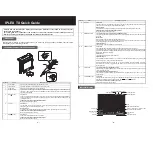
6240B DC Voltage Current Source/Monitor Operation Manual
5.2.4 Operations in Low-Resistance Measurement Pulse Source Mode
5-22
5.2.4
Operations in Low-Resistance Measurement Pulse Source Mode
Dissimilar metal contact generates thermal electromotive forces.
Such a thermal electromotive force primarily causes measurement errors when low resistance is measured.
The 6240B has the "low-resistance measurement pulse source mode" that can cancel thermal electromo-
tive forces. This function makes it possible to measure precisely resistance such as the resistance of con-
nectors or wire harnesses.
Positive and negative pulse currents are generated and the measurement are performed twice to cancel
thermal electromotive forces.
Measured value = |Vma - Vmb| / (|Is|
2)
Vma = Vo + Vd1 + Vd2
Vo = Is
RL
Vmb = -Vo + Vd1 + Vd2
Vd1, Vd2; Thermal electromotive force
Measured value = |(Vo + Vd1 + Vd2) - (-Vo + Vd1 + Vd2)| / (|Is|
2)
= 2Vo / 2Is
= Vo / Is
The low-resistance measurement pulse source mode requires consideration of the measurement delay time
(Td) because it executes voltage measurement by current pulse generation.
If Td is not set appropriately, the measurement points (Vma, Vmb) will be on the way to the rising edge
so that precise measured values cannot be obtained.
To secure precise measurements, make Td enough larger than the current source settling time (Ts).
For more information on Ts, refer to Section 5.2.9.2, "Measurement Delay and Settling Time."
e.g.) Td for current source value: 1A, response: Slow and 100 m
measurement
Ts =
(26
s
VRL) / (Is
Rs) + 100
s
Ts: Settling time
= (26
s
0.1 V) / (1 A
0.25) + 100
s
VRL = 100 m
1 A = 0.1 V
= 110
s
Is = 1 A
Rs = 0.25
Td >> Ts. Thus, Td = 600
s
(Setting Td more than five times of Ts is recommended.)
The following table shows operations in the low-resistance measurement pulse source mode.
















































